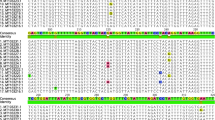Abstract
From June 2011 to February 2012, a total of 451 wild boar carcasses from eastern regions of Austria were tested for the presence of Alaria alata mesocercariae by means of a migration technique. Mesocercariae were recovered from carcasses from the province of Lower Austria (25/337 carcasses) and the Burgenland (5/64), but not from Vienna (0/50). In positive samples (fatty and glandular tissue and muscle), the median number of mesocercariae was 4.5 per 35 g. Within districts, but also between animals hunted at the same day in the same hunting area, frequencies of detection varied considerably.

Similar content being viewed by others
References
Auer H (2011) Jagdbares Wild als parasitäre Infektionsquelle für den Menschen in Österreich. Vet Med Austria 98:245–250
Bagrade G, Kirjusina M, Vismanis K, Ozolins J (2009) Helminth parasites of the wolf Canis lupus from Latvia. J Helminthol 83:63–68
BFR (2007) Bundesinstitut für Risikobewertung. Wildschweinfleisch kann den gesundheitsgefährlichen Duncker'schen Muskelegel enthalten. Statement 027/2007 of 1 July 2007
Bruzinskaite-Schmidhalter R, Sarkunas M, Malakauskas A, Mathis A, Torgerson PR, Deplazes P (2012) Helminths of red foxes (Vulpes vulpes) and raccoon dogs (Nyctereutes procyonoides) in Lithuania. Parasitology 139:120–127
Duscher G (2011) Der Dunckersche Muskelegel – Alaria alata beim Rotfuchs in Österreich in Relation zum Vorkommen von Wildschweinen. Vet Med Austria 98:251–254
European Commission (2005) Commission Regulation (EC) no. 2075/2005 of 5th December 2005 laying down specific rules on official controls for Trichinella in meat. Official Journal of the European Union L 338:60-82
Freeman RS, Stuart PE, Cullen SJ, Ritchie AC, Mildon A, Fernandes BJ, Bonin R (1976) Fatal human infection with mesocercariae of the trematode Alaria americana. AmJTrop Med Hyg 25:803–807
Hinaidy HK (1976) Ein weiterer Beitrag zur Parasitenfauna des Rotfuchses, Vulpes vulpes (L.), in Österreich. Zbl Veterinärmed B 23:66–67
Jaksic S, Uhitil S, Vucemilo M (2002) Nachweis von Mesozerkarien des Saugwurms Alaria alata im Wildschweinfleisch. Z Jagdwiss 48:203–207
Kutzer E, Hinaidy HK (1971) Die parasiten der wildschweine (Sus scrofa L.) Österreichs. Z. Parasitenk 35:205–217
Lücker E (2010) Untersuchungen zur Prävalenz des Duncker'schen Muskelegels in Wildtierpopulationen. Forschungsprojekt Nr. 2808HS012. Bericht an das Bundesministerium für Ernährung, Landwirtschaft und Verbraucherschutz und die Bundesanstalt für Landwirtschaft und Ernährung. University of Leipzig, Leipzig
Möhl K, Große K, Hamedy A, Wüste T, Kabelitz P, Lücker E (2009) Biology of Alaria spp. and human exposition risk to Alaria mesocercariae—a review. Parasitol Res 105:1–15
Popiolek M, Szczesna J, Nowaka S, Myslajeka RW (2007) Helminth infections in faecal samples of wolves Canis lupus L. from the western Beskidy Mountains in southern Poland. J Helmithol 81:339–344
Portier J, Jouet D, Ferte H, Gibout O, Heckmann A, Boireau P, Vallee I (2011) New data in France on the trematode Alaria alata (Goeze, 1792) obtained during Trichinella inspections. Parasite 18:271–275
Riehn K, Hamedy A, Große K, Zeitler L, Lücker E (2010) A novel detection method for Alaria alata mesocercariae in meat. Parasitol Res 107(1):213–220
Schuster R, Schierhorn K, Heidecke D, Ansorge H (1993) Untersuchungen zur Endoparasitenfauna des Marderhundes Nyctereutes procynoides (Gray, 1834) in Ostdeutschland. Beitr Jagd Wildforschung 18:83–87
Segovia JM, Torres J, Miquel J, Llaneza L, Feliu C (2001) Helminths in the wolf, Canis lupus, from north-western Spain. J Helmithol 75:183–192
Sielaff H (1962) Trichinenschau. VEB G. Fischer, Jena, pp 66, 79f
Statistik Austria (2011) Annual hunting bags. www.statistik.gv.at. Accessed 1 Oct 2011
Sutor A, Schwarz S, Conraths FJ (2011) The raccoon dog (Nyctereutes procyonoides) in Germany—an established Neozoon as host and vector for parasites and other pathogens. Berl Münch Tierärztl Wochenschr 124:457–464
Szafranska E, Wasielewski O, Bereszynski A (2010) A fecal analysis of helminth infections in wild and captive wolves, Canis lupus L., in Poland. J Helminthol 84:415–419
Winkelmayer R, Paulsen P (2011) Lebensmittelhygienisch relevante Parasiten bei frei lebendem Wild und deren Detektierbarkeit. Vet Med Austria 98:239–244
Acknowledgments
The study was supported by the “Verein Grünes Kreuz”, Vienna, Austria.
Author information
Authors and Affiliations
Corresponding author
Additional information
Communicated by H. Kierdorf
Rights and permissions
About this article
Cite this article
Paulsen, P., Ehebruster, J., Irschik, I. et al. Findings of Alaria alata mesocercariae in wild boars (Sus scrofa) in eastern Austria. Eur J Wildl Res 58, 991–995 (2012). https://doi.org/10.1007/s10344-012-0642-2
Received:
Revised:
Accepted:
Published:
Issue Date:
DOI: https://doi.org/10.1007/s10344-012-0642-2




